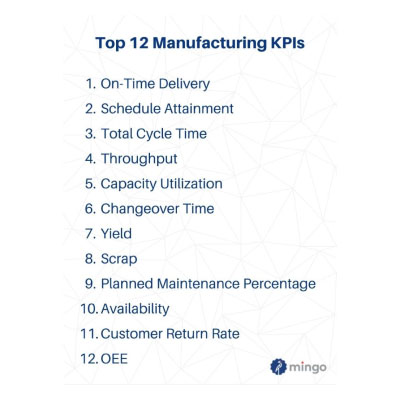How to track production in manufacturing?
It’s no easy feat. Manufacturers often struggle with this because there are just so many manufacturing metrics to measure. How do you know which KPI production metrics to measure and when?
This is part of the series of blog posts we are writing called “Measuring for Excellence“, in which we’ll be exploring the strategies and best practices some of the most successful companies employ to build a culture of manufacturing excellence in their organization. This includes building great behaviors and habits within the organization, engaging employees, implementing daily production meetings, and focusing on more than just software.
Of course, being in the data business, we’ll be paying special attention to the manufacturing Key Performance Indicators (KPIs) they track in order to measure their progress. We will also look at how manufacturing analytics can track manufacturing metrics in real-time on shop floors.
How to track production in manufacturing? It’s no easy feat.
Manufacturers often struggle with this because there are just so many manufacturing metrics to measure.
How do you know which KPI production metrics to measure and when?
This is part of the series of blog posts we are writing called “Measuring for Excellence“, in which we’ll be exploring the strategies and best practices some of the most successful companies employ to build a culture of manufacturing excellence in their organization.
This includes building great behaviors and habits within the organization, engaging employees, implementing daily production meetings, and focusing on more than just software.
Of course, being in the data business, we’ll be paying special attention to the manufacturing Key Performance Indicators (KPIs) they track in order to measure their progress.
We will also look at how manufacturing analytics can track manufacturing metrics in real-time on shop floors.
In this blog, we thought it would be useful to list out the top KPIs used by manufacturing leaders to create sustainable manufacturing excellence and follow lean manufacturing processes.
Additionally, you’ll learn how to track progress using a manufacturing KPI dashboard such as Mingo. So, what are key performance indicators for manufacturing plants?
1. On-Time Delivery
Work Orders Delivered by the Original Schedule Date ÷ Original Schedule Work Orders Due
This KPI measures the percentage of orders delivered on-time. The metric is often tallied monthly for statistical relevance and the aim should be 100% fulfillment.
What good is a 100% OEE if we don’t have any customers to sell our product to?
The metric is a favorite of ours ever since we learned it was the number one business goal of one of our best customers, a large contract manufacturer.
In the CEO’s office, it was listed number one among many other goals on the whiteboard and was circled for extra emphasis. This metric was the number one indication of operations efficiently operating.
When asked about this KPI, he responded:
“As long as we are hitting this, we are less concerned about OEE, or even machine downtime,” he told us. “What good is a 100% OEE if we don’t have any customers to sell our product to?”
2. Production Schedule Attainment
Work Orders Delivered by the Original Schedule Date ÷ Original Schedule Work Orders Complete
This KPI tracks how often the production team meets the target level of production and provides an important way to set performance benchmarks, fine-tune work order delivery time estimates, and make sure that performance issues aren’t causing costly delays.
If a manufacturer only tracks On-Time Delivery, for instance, issues within the production process itself might be obscured and the change undocumented.
One of the keys to ensuring on-time delivery, if tracked daily, production schedule attainment keeps the production team’s eyes on the prize and could eventually be tweaked to track a level of early delivery performance as well.
This is a very important KPI production goal.
3. Total Cycle Time
The total cycle time measures the time it takes for a customer order to start and finish the entire production process all the way to shipping.
It represents the full time required to convert raw materials into finished goods from one end of the line to the other.
A cycle time KPI is the average of all cycle times of all orders in a specific period and is generally calculated using Machine Cycle Time.
At the core of any plant performance manufacturing metrics is machine cycle time, defined in detail here.
This measure of efficiency sets the bar for how efficient a machine is and allows for real-time reporting on that machines performance (on the minute).
Each machine should have an Ideal Cycle Time based on the part being produced.When viewed as set of multiple cycles, it can be measured as Cell Cycle Time.
4. Throughput
Units Produced / Time
This manufacturing KPI is the rate of how many units on average a machine, cell or line is producing over time, i.e. 1200 units/minute.
While cycle time is the measure of the time it takes between two points, throughput should be monitored in real-time since, when throughput decreases, it is usually indicative of an issue on the line.
Throughput can be increased by eliminating downtime, calibrating machines to run at an ideal cycle time, reducing the number of touches or steps in a cycle to reduce shortstops, changing the raw materials or tooling required to produce the good, and improving machine maintenance.
5. Capacity Utilization
Actual Output / Potential Output x 100
If a machine is producing goods at an ideal cycle time, it is said to be running at 100% capacity.
When running slower or anytime a machine is idle, this percentage will drop, indicating available capacity and slack in the system.
This is a great KPI to understand the facility’s ability to scale production or institute more agile job scheduling during production time.
6. Changeover Time
Changeover time is the time it takes to unload/load, retool, calibrate, and program a new job.
Changeover is most relevant when there’s a switch between one type of part to another before a production run.
When taken as an average, this KPI can help determine which job types and parts might require some reduction in setup time if possible.
By tracking changeover time, manufacturers can define total cycle times by part, fine-tune their estimates, and recognize the need for more operator training, better planning, proactive prep of required materials.
7. Yield
Good Parts Produced / Total Units Produced
The yield KPI is a measure of quality and performance and is at the heart of production efficiency and profitability.
It. may be one of the most important KPI production measurements.
Measuring First Pass Yield (FPY) will identify which processes require substantive re-work which will affect throughput, influence total cycle times, and provide a target of a 100% yield in which no defective parts were produced at all.
8. Scrap
Total Scrap / Total Product Run
Scrap is the discarded or rejected material from the manufacturing process, so it can be a measure of units or volume.
Some organizations track scrap manufacturing metrics as defective items as scrap (waste), while others focus on the leftover raw material from a subtractive manufacturing process.
However your organization defines scrap, tracking this manufacturing KPI should be one of the first steps to lowering your material costs, possibly increasing cycle times, and focusing on producing more quality goods.
Without real quality improvements, scrap is just money going down the drain.
9. Planned Maintenance Percentage (PMP)
Planned Maintenance Time / Total Maintenance Time
This KPI is a combination of calculating the percentage of scheduled maintenance vs. planned maintenance plus all the emergency maintenance required to address breakdowns.
PMP is essential for manufacturers to appropriately allocate resources for preventative maintenance.
One rule of thumb established by advocates of preventative maintenance is 85% PMP, in which an organization is targeting less than 15% maintenance time be dedicated to emergency work orders.
Since emergency fixes can cost on average 3-9 times more than planned maintenance due to overtime, rushed parts, service call-outs, or scrapped production, this metric should be stable for manufacturing business seeking uptime and trying to lower operational costs.
This manufacturing metric is very important in creating a healthy maintenance culture. Measuring the right metrics and involving everyone in the plant with maintenance activities can make a big impact.
10. Availability
Uptime / Uptime + Downtime
At the core of most manufacturing reporting is the availability KPI – the measure of machine uptime and downtime.
Downtime is by far the biggest loss facing most manufacturers today. No matter what industry you are in, downtime costs money.
Ideally, availability should take into account all downtime, making no distinction between whether it is planned or unplanned.
Also, in order to address the issues causing downtime and reduce it, manufacturers need to start tracking downtime reasons so when viewed on a Pareto Chart, downtime can be analyzed within the context of the machine affected, by operator and shift, and by any other factor on the plant floor.
Mingo collects manufacturing metrics and displays them in your Pareto Charts, automatically, on real-time dashboards. Watch a demo to see how it works.
11. Customer Return Rate
Rejected Goods / Total Number Of Goods Delivered
As a measure of performance, increasing customer returns might indicate a flaw in the production process or a missing step in quality control.
The costs of customer returns can quickly escalate due to the rework required and the effort and cost of reverse logistics.
12. OEE – Overall Equipment Effectiveness
Availability Performance Quality
OEE is fine and well– and it has its place in the industry, but we feel strongly that many manufacturers track OEE as a safeguard, believing that if they achieve a high enough OEE, they are operating at a level of manufacturing excellence – something we fundamentally dispute. (In fact, we strongly believe OEE is a flawed metric.)
We’ve talked a lot in the past about what’s good and what isn’t regarding the metric (so for our extended take on OEE, see here).
Learn more about calculating OEE, here.




